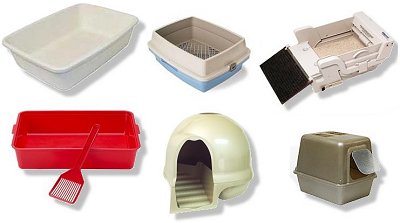| Choosing the Litter Box This article written by Glenda Moore |
|
| Choosing the right
litter box is an important consideration for both you and your cat.
There are many styles, sizes, and features. Features to Consider
Remember that ideally, you should provide one litter box for each cat in your household. A shallow box is appropriate for kittens (about 3 inches), and a deeper variety for adult cats (about 6 inches). We've found that the deeper the better, for male cats. Note that it's important to clean the boxes thoroughly with soap and water. Basic flat box – This is the least expensive variety, comes in an assortment of sizes and depths. Simple to clean, and preferred by many cats. Basic flat box with rim - This is the basic rectangular box, with a "lip" which helps prevent litter from being kicked out. Covered box - This is our preference, a traditional rectangular shape with a "hood" that covers the box. The opening at one end allows the cat to enter and exit. Some litter boxes have a swinging door - we always remove it, as our cats don't like being totally confined. These boxes offer more privacy for cats (though some skittish cats may feel trapped). Ensure that the box is large enough for your biggest cat to be able to turn around and fully stand erect. This box is recommended if you have male cats who spray. Note that it's important to have some sort of ventilation in the top to help with odor control. |
Self-cleaning box – Several
companies have come out with motion-activated “self-cleaning” litter
boxes. A timed sensor is activated a few minutes after your cat leaves
the box, and a rake scoops the matter into a receptable, which is then
manually emptied every couple of days. You may need to experiment
(a lot) with the scoopable litter that works best for these litter
boxes. Some cats don't like the mechanical action. Be sure
to check into the guarantee. Sifting boxes – The basic model consists of two rectangular pans and a “sifter tray”. The two boxes stack on each other, with the sifting tray inside the top pan. To clean the box, the two litter boxes are separated and the sifting tray is lifted out which removes the wastes but leaves the litter. The sifter is then put into the empty box and the litter is pour on top. After the waste is dumped, the empty litter box on the bottom of the unit. You may need to experiment with litter box styles. Before giving up on any litter box, however, realize that it might not be the box itself that is the problem. Try a variety of fillers, and at various depths. And, of course always keep it clean, using soap and water or a very weak (10 to 1) solution of bleach and water. Never use Lysol or Pine-Sol or the like, as it can be harmful to cats. Where you place the litter box is critical. It must be in a quiet area, away from the cat's food and water. Whatever style litter box you choose, be sure your cat has privacy. If you use a pan-style rather than a covered box, hide it with a privacy screen. You can also "hide the litter box in plain site" - in a vinyl wicker look box, table, etc., but it is imperative that it must be out of traffic. See related articles titled Choosing the Litter Box Filler and Why Has My Cat Stopped Using the Litterbox?? for information concerning location and other issues. |
 |
|